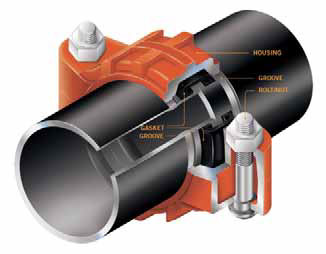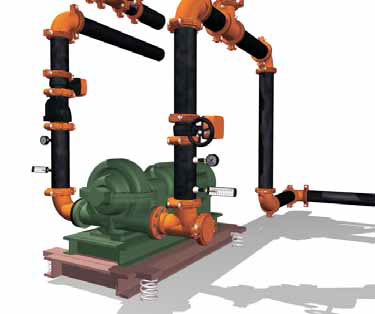Unanticipated noise and vibration can be problematic for both occupants and processes within structures. Noise and vibration in piping systems can originate at pumps and other mechanical equipment. If the system design does not accommodate vibration, a variety of issues ranging from annoyances to actual business interruptions can occur.
Traditional Vibration Reduction
Designers have traditionally specified elastomeric flexible arch connectors to minimize noise and vibration where pumps connect to piping systems. These flex connectors create a discontinuity in the metal piping, which reduces the amount of vibration transmitted down the line. Commonly constructed of nylon, DacronÒ or polyester, these connectors are often spheroidal in shape to permit deflection in all directions. The disadvantage is in the weakness of the elastomeric arch: the lack of metallic containment and compression rather than pressure-responsive sealing.
The elastomeric flex connector's shape allows pressure to exert in all directions, but this often requires control units such as restraining rods, plates and/or anchors. These items are used to prevent excessive stretching of the unsupported elastomer due to system pressure thrusts. However, when such thrusts occur repeatedly and the connector is overextended through time, use and pressure, rupture or leakage can result. The connectors can be fairly expensive, and installation can be time consuming due to the complexity of the reinforcing systems. The compression sealing of the flanged construction often requires re-torquing to maintain a leak-tight joint.
Couplings' Sound and Vibration Reduction Qualities
Flexible couplings have proven as effective as flex connectors in handling deflection and reducing noise and vibration in commonly experienced frequency ranges. Couplings included in grooved mechanical piping systems provide additional performance benefits, making them a good option for pump connections, as well as joints throughout entire piping systems. These benefits include prevention of overstretching, and accommodation of deflection, expansion and contraction.

The elements of a grooved pipe joint
The mechanical joint, or coupling, is comprised of four elements: grooved pipe, a gasket, coupling housings, and nuts and bolts. The pipe groove is made by cold forming or machining a groove in the pipe end. A gasket enclosed in coupling housings is wrapped around the two pipe ends, and the key section of the coupling housing engages the groove in the pipe. The bolts and nuts are tightened with a socket wrench or impact wrench to hold the housings together. In the installed state, the coupling housings encase the gasket and engage the groove around the circumference of the pipe to create a leak-tight seal in a self-restrained pipe joint.
Like a flex connector, the coupling reduces vibration and noise transmission while handling deflection. The elastomeric gasket creates a discontinuity similar to that of a flex connector, while the design of a flexible coupling allows the joint to accommodate up to 5 deg of deflection.

3-D model of a pump with flexible couplings
The design of the coupling is different from a flex connector. The coupling's housings hold the gasket in compression to create a seal against the pipe, while providing both space for the elastomeric material to flex, and containment to prevent overstretching. Full metallic containment is provided. Couplings maintain noise and vibration attenuation qualities, as well as the ability to accommodate deflection, expansion and contraction, throughout the piping system's life.
The gasket material attenuates vibration as well as noise transference, and the ductile iron housings provide vibration-dampening qualities due to the materials' inherent dampening coefficient. In fact, testing conducted by SSA Acoustics in Seattle showed that three couplings placed in series in a pipe section dampened overall vibration amplitude by 80 to 90 percent, with each successive joint creating a further reduction in vibration.
Additional Benefits of Grooved Piping Systems
This compounding effect provides good incentive to use couplings throughout the length of a piping system, not just at pump or equipment connections. The sound- and vibration-dampening qualities of couplings are just one of the reasons grooved mechanical piping systems are specified on a variety of piping services. Some of the better-known reasons that grooved systems are specified over welded and flanged systems include ease and speed of installation and maintenance, safety and reliability. Where flexible couplings are used, stress induced into pump housings by alignment variables can be minimized.
In terms of installation, grooved systems are up to 10 times faster to install than other pipe-joining methods. The process of joining grooved piping is as simple as aligning the pipe ends, assembling the coupling on the joint, and tightening the nuts and bolts with standard hand tools. Some manufacturers offer "installation-ready" couplings that are even faster to install than standard couplings because they do not need to be disassembled prior to installation. The coupling can simply be pushed onto the pipe ends and tightened.
Welding is an inherently dangerous task. Not only does the process expose site personnel to health concerns, it also creates a fire hazard. The welding process releases toxic fumes and particulate matter that unnecessarily put the welder and other workers in the vicinity at risk. The use of couplings removes this risk along with the potentially time-consuming filing of "hot work" permits and other site precautions.
Once assembled, proper installation can be visually confirmed, without the use of X-rays or other NDE methods, by verifying that the coupling housings meet metal-to-metal on the bolt pads.
The speed and ease of installation also carries over into system maintenance. Once installed, a coupling provides a union at every joint. Should the piping system need to be accessed for maintenance, two couplings can be disassembled, and the pipe section needing maintenance can be easily removed. While maintenance is performed on one part of the piping system, appropriately placed couplings can allow for ease in rerouting the system to reduce downtime.
Unlike flanges, which must be consistently tightened to avoid gasket slippage, a coupling's nuts and bolts do not need to be tightened during routine maintenance. A flange puts variable stress on the gasket, nuts and bolts, whereas a coupling holds the gasket in compression from the outside of the pipe joint. While the coupling's bolts and nuts hold the housings together, the coupling holds the pipe ends together.
Like a welded or flanged joint, rigid couplings provide a strong, sturdy, inflexible joint. Flexible couplings can also be used in other places throughout the piping system where flexibility is needed to accommodate deflection, thermal expansion and contraction, and/or seismic movement.
Grooved piping systems have been specified in some of the world's most demanding construction projects, including the Hoover Dam and the recently completed Burj Dubai-the world's tallest building.
Grooved piping is generally accepted for virtually all piping in underground mines and hydraulic elevators, and the preferred method for fire protection systems and HVAC piping. In the industrial sector, couplings are used in specialty process and utility piping systems in the oil sands, power generation, oil production and reverse osmosis industries, among others. The grooved system's use in these demanding applications speaks to the method's reliability. When it comes to reducing noise and vibration, couplings are one solution with a host of benefits.
Pumps & Systems, May 2010


